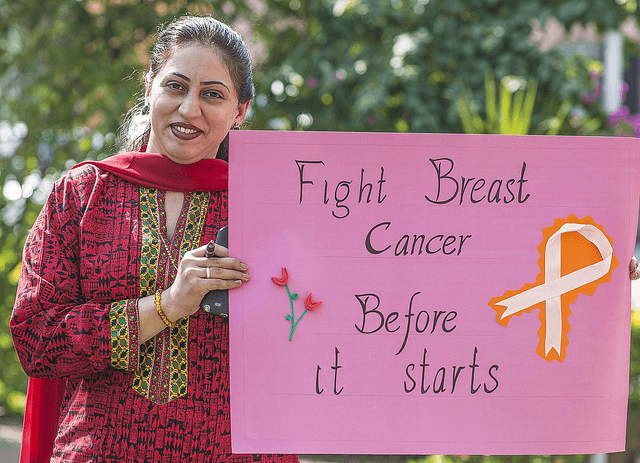Today, cancer is one of the leading causes of death in our world. Cancer begins with an abnormal growth of cells that can form a mass called a tumor, which can possibly invade nearby tissues. Similarly, in breast cancer, tumors form in the breast tissue. As with any type of cancer, early detection is critical for overcoming the disease and ensuring good health in the future. Every woman by age 20 should start these examinations. Fortunately, there’s a way to detect breast cancer early on: an easy-to-follow self exam that can be done at home.
Image Source: Dan Dalton
There are five simple steps in the breast self-exam, which can be done on your own.
Step 1: Look at your breasts in the mirror, making sure to stand straight with your arms by your sides. You should look for warning signs that include abnormal swelling, dimpling of the skin, redness, and/or soreness. Be aware of any changes in the position of the nipples, or if they seem to be inverted.
Step 2: Raise your arms slightly, this time focusing more on the underarms for the same warning signs and changes. Raising your arm straight up leads to tightening of the tissue and makes it harder to identify any abnormalities. Thus, it is important to only slightly raise your arms.
Step 3: Look for any discharge coming out of one or both nipples. Nipple discharge is any fluid that comes out of the nipple area in the breast. It can be watery, milky, yellow, or even bloody. It is important to note if fluid comes out whether or not you are touching your nipples, as they indicate different possibilities. If it comes out while touching your nipples, the discharge can be due to pregnancy, infection, or use of certain medications. However, if it appears on its own, it could be due to tumors.
Step 4: Lie down on your side in order to check for any abnormal lumps under and around the breasts. Use your right hand to feel your left breast and your left hand to feel your right breast. Be sure to use a firm touch as you feel your breasts to check for lumps; your fingers should be flat on the skin, and you should make small circles as you move around the entire area of the breast. Small circles are effective as it moves the underlying tissue and enables you to thoroughly check for lumps. Do this for the entirety of your breast, from collarbone to ribs, cleavage to armpit. Studies have shown an up-and-down feeling pattern to be most effective in covering all breast tissue.
Step 5: Repeat step four, except while sitting up or standing. Doing so in a different position accounts for the different placement of tissues and allows you to check more thoroughly for any lumps that may have been missed. Checking for lumps, thickening, or hard knots in the breast might be easiest in the shower, as the skin is wet and smooth, so your fingers can move around and probe into tissue more easily. Make sure you notify your healthcare provider if you find any abnormalities.
Do not panic if you find a lump during this breast self-exam. Only 20% of women who find a lump and report it to their doctor are diagnosed with breast cancer. However, it is important to get in the habit of doing a self-examination to not only familiarize yourself with your body so that you can detect changes quickly, but also for the early detection and prevention of cancer. Breast self-exams are quick and easy; you can even do them every morning in the shower. So why not start today?
Feature Image Source: Breast Cancer Campaign 2013 by UN Women Asia and the Pacific










